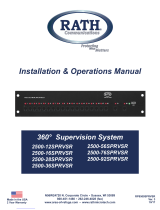
Page 10 of 144 Attendant console
553-3001-215 Standard 12.00 January 2002
If an attendant console must be returned to the factory, pack it in the
appropriate container to avoid damage during transit. Remember to include
all loose parts (cords, handset, power unit, labels, and lenses) in the shipment.
Installation and removal
Use the following procedures to install and remove M2250 attendant
consoles.
Note: Although M2250 attendant consoles do not require a static
discharge ground connection, the connection should be installed to
protect any earlier vintage attendant consoles that may be used as
replacements.
Choose a clean, level work surface and place several sheets of soft, clean
paper between the attendant console and the work surface. This will prevent
scratching or otherwise damaging the top cover, LCD indicators and screen,
and the feature keys of the attendant console.
Procedure 2
Installing the M2250 attendant console
1Ensure that a 16-pair or 25-pair cable equipped with a 25-pair
Amphenol connector is installed at the attendant console’s location.
2Unpack and inspect the attendant console for damage. If the console
is damaged, notify your supplier.
3Designate the console according to the features provided.
4Connect the Amphenol plug on the attendant console to the Amphenol
jack coming from the Main Distribution Frame (MDF).
• Fasten the Amphenol connectors together and secure the
captive screws on the cable.
• Ensure that the connectors are secured in a connector
mounting, if provided, or to the wall. Do not leave connectors
unprotected on the floor.
5Add a line circuit for the attendant console, if not already done. Refer
to Circuit Card: Installation and Testing (553-3001-211).
6Cross-connect the attendant console at the cross-connect terminal.
SeeProcedure1onpage18.




















